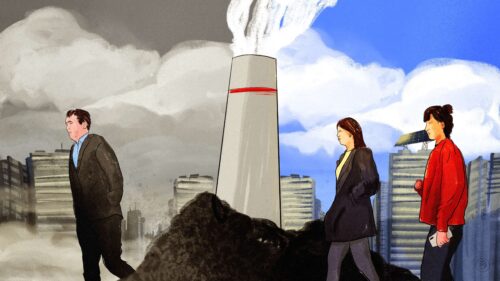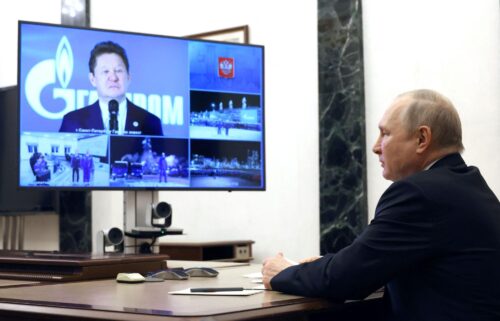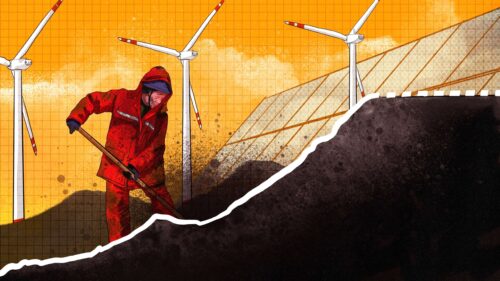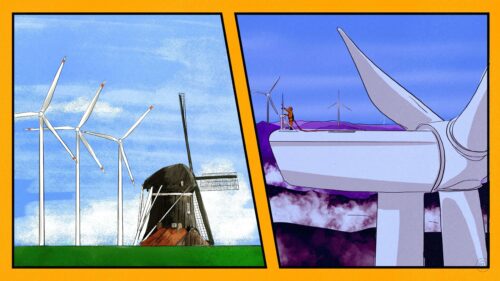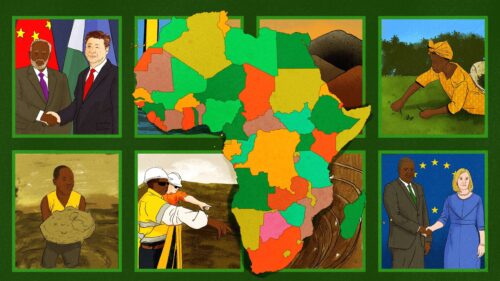Meet the wind energy billionaire who owns the fastest electric car racing team on the planet
Envision founder Zhang Lei is building a global green energy network in China, Japan, Europe, and the U.S. Who is he?
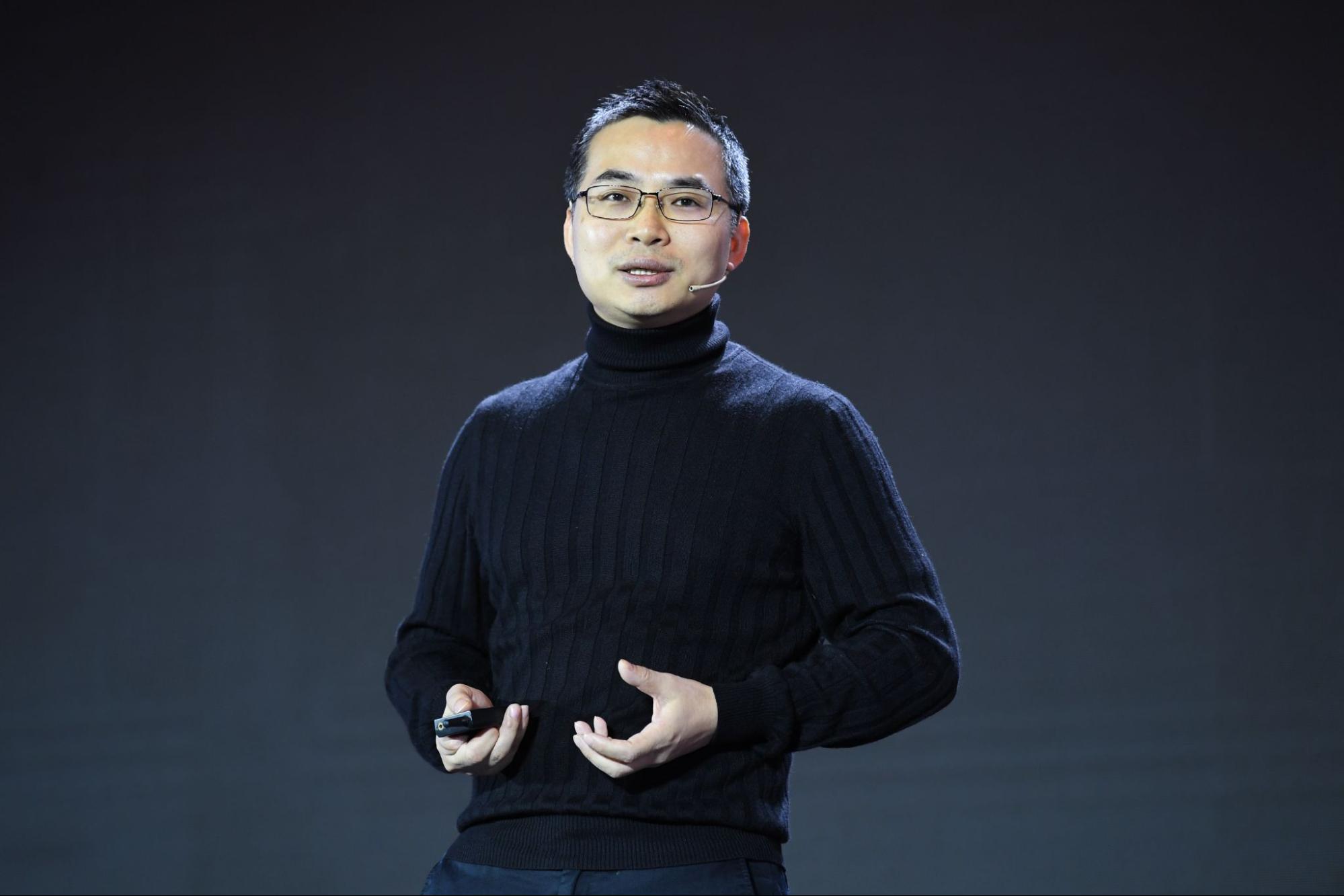
Zhāng Léi 张雷 is the founder and CEO of Envision Energy, one of the world’s biggest wind turbine manufacturers. It’s a privately held company that also owns the fastest electric car racing team in the Formula E circuit, and has majority stakes in some of the world’s most important battery factories in Spain, France, China, the U.K., and the U.S.
Zhang is trying to spread the idea of an integrated, self-sufficient energy network he calls “Green Utopia,” and a leading Chinese environmentalist calls his vision “thrilling.” He is like a Chinese Elon Musk, but so far without the bombast and need for constant attention.
So who is he?
Zhang, 47, grew up east of Shanghai in Jiangyin, near Wuxi, on the banks of the Yangtze River in Jiangsu Province. His father, Zhāng Shìquán 张士泉, earned a good living by starting a foundry equipment plant in 2001. He was so successful that he eventually became known as the “foundry equipment king” (铸造设备大王 zhùzào shèbèi dàwáng).
The business was part of China’s industrial boom when factories spewed filth into the air and water. Zhang Lei grew up in this environment, which perhaps partly inspired his vision — as described on the website of his Formula E team — of not seeking just to make revenue and profit but of “combining art and science” to achieve “beautiful energy.”
Envision Energy was founded in 2007 to make this happen, and he has grand ambitions. In 2019, Zhang advised the National People’s Congress (NPC), China’s annual parliamentary session, on the country’s draft Energy Law. In the run-up to that year’s NPC session, Zhang stated in interviews that “an excellent company needs to be ahead of the government. The company must foresee the future development trend before the government, and even inspire the government.” In answer to a question on why Envision is not a listed company, Zhang answered that remaining privately held was the “correct development path” (正确的发展方向 zhèngquède fāzhǎn fāngxiàng) for Envision, which he described as Microsoft, Tesla, and Google rolled into one.
In late 2022, a year in which China’s carbon emissions from energy production were the highest in the world at 12.1 gigatonnes (Gt), while those in the U.S. were 4.7 Gt, International Energy Agency (IEA) data showed, Zhang told TIME magazine he was inspired by the idea of “harmonizing energy and the environment.” But Zhang said he wanted to help reduce emissions everywhere, not just in China.
Green report card
In 2021, Envision said it planned to achieve carbon neutrality across its operations by the end of 2022, and carbon neutrality in its entire value chain six years later.
“Envision’s commitment to reach carbon neutrality across the entire value chain in 2028 is one of the earliest and most thrilling in the corporate sector,” environmental journalist and activist Mǎ Jūn 马军 told The China Project.
Director of the Institute of Public and Environmental Affairs in Beijing, Ma developed the Corporate Climate Action Transparency Index (CATI) to assess if companies are cleaning up or greenwashing their pollution output. Envision’s preliminary 2023 CATI score is 54.1 out of 100, which makes it one of the front-runners on climate action in China.
However, Ma expressed concern about the carbon inventory and disclosure data Envision claimed to have collected from more than 150 of its key suppliers. Although Envision has committed to pushing its suppliers to use only renewable energy by 2025, Ma said that so far, “we haven’t seen any disclosed progress, and its pathway to achieving net zero across their value chain is also unclear.”
Envision’s lack of transparency presents the sector and consumers with a conundrum. On the one hand, Zhang Lei’s company is a renewable energy juggernaut and one of China’s leading wind energy manufacturers, and on the other hand, it is difficult to wade through the company’s pronouncements about an energy revolution.
The China Project asked Envision for an interview with Zhang but received no response.
Son of privilege
Zhang Lei is often depicted in the Chinese press as a quintessential child of second-generation wealth, a fùèrdài 富二代 who experienced his family’s transition from poverty to opulence as he grew up.
Like many fuerdai, Zhang got an expensive education. In 1999, he graduated from the University of Shanghai for Science and Technology with a degree in international business management. He then set off for the London School of Economics (LSE), where the Mathematics Department website describes his postgraduate degree in Operations Research and Analytics as teaching “the skills needed to apply mathematical methods to real-world analytics problems faced by companies.”
After LSE, Zhang could have returned to the now extensive family foundry business in Jiangsu Province, eventually taking over the reins of the range of companies, in one of which he became a shareholder in 2005. Instead, Zhang stayed on in London and took jobs in The City, first as a trading strategist at the French oil giant Total, and then as a derivatives trader at Barclays Bank.
Then, in 2007, when Zhang was 31, he had a big idea, and he had the global business connections to help him launch it back home in China.
China news, weekly.
Sign up for The China Project’s weekly newsletter, our free roundup of the most important China stories.
It started with wind
Soon after he arrived back in Jiangyin, Zhang founded Envision Energy, a wind turbine manufacturer, with about a dozen colleagues including Felix Zhang (张旭宇 Zhāng Xùyǔ, no relation) a man with degrees from Harvard and Stanford who had worked in London in 2004-2005 — the same time as Zhang Lei — as an equity analyst for Morgan Stanley.
At the outset, Envision was supported by the local governments of Wuxi and Jiangyin, whose large investments and subsidized loans allowed the company to build a plant and hire workers. While government regulations were pushing international wind energy manufacturers out of China, Zhang Lei hired away their technical experts, recruiting from Danish wind giant Vestas and the German-Spanish film Siemens Gamesa.
In 2008, Envision produced its first wind turbine, followed a year later by its first big order: thirty-three 1.5 MW wind turbines for Longyuan Power, then Asia’s largest wind power generator. By 2014, Envision was among China’s top three turbine manufacturers.
Philip Totaro, founder and CEO of renewables market intelligence consultancy IntelStor, advises Envision on technology development and market entry strategies.
“Their ambition was always to provide solutions and get involved in turnkey projects as opposed to simply being a supply chain company,” Totaro told The China Project. “Zhang Lei and Felix Zhang have been very carefully cultivating a brand as well as orchestrating their technology development to help them achieve the company’s ambitions.”
In 2016, Zhang Lei told People’s Daily, the flagship newspaper of the Chinese Communist Party, that he wished to attain a “Green Utopia” (绿托邦 lütuōbāng) through strategic investments, careful management of all energy sources, and integration of supply upstream and demand downstream. He said he saw an “energy symphony” in which billions of solar panels, EVs, batteries, and household appliances are conducted seamlessly by an Internet of Things network in which everyone can be both a producer and consumer of energy.
Media reports echoed all of this hype, but the company had some bad press in February 2019, when a former Envision engineer infiltrated a wind turbine installation project belonging to an Envision competitor, Mingyang, armed with a camera and a digital rangefinder used to measure distances. However, the court eventually concluded that the man was not an employee of Envision at the time and that he had taken the photos as a hobby, and the judgment cleared Envision completely.
By 2022, Envision Energy had the world’s fourth-largest newly installed wind turbine capacity that year — 8.3 GW — behind Goldwind, Vestas, and Siemens Gamesa; and today, the company claims to be China’s largest producer of “smart” offshore wind turbines. Envision has also developed a particular competency for low-speed onshore turbines and is engaged with the European Union in developing a new type of wind turbine using high-temperature superconducting (HTS) technology as an alternative to direct-drive turbines. In February 2023, Envision brought online an onshore turbine of 10 MW, calling it the world’s largest onshore turbine.
Chinese or Japanese?
In 2018, Envision Energy added EV battery manufacturing to its portfolio by acquiring 80% of Automotive Energy Supply Corp. (AESC), a company owned by Japanese carmaker Nissan, which retained a stake of 20%. With this deal, Envision acquired AESC’s plants in Japan, the U.S. and the U.K. Since then, AESC has expanded its customer base to include Honda, Mazda, BMW, Mercedes-Benz, Renault, and other global companies.
In Europe, AESC’s Chinese ownership is in plain view. On June 28, 2021, French President Emmanuel Macron joined Zhang at the unveiling of a $2.4 billion “Chinese battery factory” in Douai, northern France, to supply Renault’s EVs.
In July 2022, Zhang joined online the signing ceremony for an agreement with the Spanish government to build an AESC EV battery factory in Extremadura, in the west of the country, as well as hydrogen generation and wind turbine assembly plants.
But as Envision started expanding its U.S. manufacturing facilities beyond AESC’s first EV battery plant in Smyrna, Tennessee, the company chose to hide its Chinese ownership. On August 30, 2022, Kentucky Governor Andy Beshear helped Envision AESC break ground on a $2 billion plant in Bowling Green, designed for 2,000 locals to start producing EV batteries in a plant the size of 52 football fields, or 3 million square feet, set to be fully operational by 2027. The words “China” and “Chinese” were absent from reports on the event.
On June 7, 2023, South Carolina Governor Henry McMaster helped break ground on an $810 million investment from what he called a “world-leading Japanese electric vehicle battery technology company,” whose new plant would bring 1,170 new jobs to a 1.5 million square foot plant in Florence County set to open in 2026.
In 2022, South Carolina exported more passenger vehicles than any other U.S. state for the ninth year in a row. When it’s fully operational, the AESC plant in Florence will produce battery cells for EVs produced at a BMW facility that produces 1,500 vehicles a day, located 187 miles to the northwest in Spartanburg.
Through Envision, AESC is now more Chinese than Japanese and is a core component of Zhang Lei’s global ambitions. However, given American opposition to Chinese EV battery business in various U.S. states, Zhang and the officials of Kentucky and South Carolina chose to downplay the company’s ownership. In doing so they hoped to avoid what happened when Ford announced a partnership with Chinese EV battery maker CATL in December 2022: Virginia governor Glenn Youngkin called the project a “Trojan horse” and the plant was moved to Michigan.
In the wake of rising U.S.-China tensions following the February 1, 2023 destruction of a Chinese spy balloon floating over the U.S., the backlash against Chinese ownership extended to the U.K. In July 2023, when Indian conglomerate Tata announced plans to spend about $5 billion on a new EV battery plant in Somerset in the southwest of the U.K., it refused to confirm whether AESC was involved so as to avoid losing support from Conservative parliamentarians opposed to any of the $637 million in state aid offered Tata going to a Chinese company instead. In August 2023, The Financial Times reported that AESC is “deeply involved” in Tata’s project in Somerset.
AESC, consistently identified in media reports in the U.S. and U.K. as “Japanese,” already has a battery plant in Sunderland in the U.K.’s northeast, and is building a second plant there.
Branching out: Software and energy storage
With Envision’s wind business well established, in 2017, Zhang Lei founded Envision Digital in Singapore to produce Artificial Intelligence software to integrate photovoltaic power plants, energy storage systems, and wind farms and manage decarbonization in all energy systems.
While Envision Energy has an estimated value of $12 billion, and AESC $7.2 billion, according to the 2023 Hurun Global Unicorn List, Envision Digital clocks in at $3.6 billion. Envision Digital claims its software is in widespread use among operators of solar and wind farms, but seldom identifies specific customers or explains how its operating system works. Those customers it does name include Microsoft and the Port of Singapore Authority. Hurun lists Zhang Lei’s personal fortune at $5.2 billion.
In 2018, Envision expanded into energy storage — industrial-size batteries that can power houses, apartments, and factories. By 2022, Envision was China’s eighth-largest energy storage provider, a China Energy Storage Alliance report showed. In May 2023, Envision won a public tender to develop two liquid-cooled energy storage plants for the Harmony Energy Income Trust in the U.K., operator of about half of Britain’s battery energy storage, thereby breaking the HEIT’s dependence on Tesla, its sole partner since 2016.
Electric race cars and EV batteries
Also in 2018, Envision invested (along with Richard Branson’s Virgin Group) in a team of Formula E race cars — a global circuit of electric vehicles only slightly slower than their gasoline-powered counterparts in Formula 1. In 2020, the U.K.’s Carbon Trust certified the team carbon neutral and in November 2021, Envision bought out Branson, ditched the Virgin name, rebranded the team Envision Racing, and painted the speedy EVs green to match their claim to being “the greenest team in Formula E.”
Formula E cars produce no carbon emissions and speed around the track without the signature high-pitched engine wail of Formula 1 cars. Envision Racing showcases the company’s EV battery technology and, in the 2022/2023 season of 16 rounds, the team finished at the top of the standings, beating out 9 other teams.
“Envision’s EV battery and grid energy storage technology has become more desirable due to the investment made in the quality of those solutions, particularly driven by their involvement in Formula E and development of distinct intellectual property around their grid energy storage technology,” Envision advisor Totaro of consultancy IntelStor said.
Still, Envision’s EV battery maker AESC is experiencing growing pains at its U.S. facilities. Anonymous employee reviews posted on the site Glassdoor dating back to 2020 were mixed — complimentary about the pay but critical of the long hours and poor benefits, and of management’s poor communication skills. In 2020, when AESC was laying off staff due to COVID, a reviewer claiming to be a supervisor with five years’ experience at the Smyrna, Tennessee plant, wrote that morale had plummeted since Envision bought AESC.
Note: This article was edited after publication to clarify that the mentioned court case ended in Envision being completely cleared of all charges, and that some of AESC’s customers were won only after Envision became its major stakeholder.
Companies:
- Envision Group 远景科技集团
- Envision Energy 远景能源
- AESC 远景动力
- Envision Digital 远景智能
- Longyuan Power 龙源电力集团
- BMW
- Tata
- Nissan
- Ford
- CATL
- Gotion High-tech
- Vestas
- Virgin Group
- Siemens Gamesa
- Goldwind Science and Technology 金风科技
Links and sources:
- China’s wind power companies are giants, but they aren’t going to take over the world — yet / The China Project
- Wind power bottlenecks between China and the West are slowing down green energy adoption / The China Project
- The U.S. cannot do without Chinese battery companies, and these are the ones that matter / The China Project
- Envision Group’s CEO Zhang Lei Has No Time for Greenwashing / Time
- China’s record carbon emissions expected to peak due to clean energy push, report says / CNN
- CO2 Emissions in 2022 / IEA
- Envision AESC to establish Florence County electric vehicle battery gigafactory / SC.gov
- New EV battery plant bringing nearly 1,200 jobs to Florence County / WBTW
- SC leads nation in exports of tires, completed passenger vehicles / Live 5 News
- Electric car battery factory breaks ground in Bowling Green / WBKO
- Groundbreaking advances emerging vehicle battery production / AP
- China’s Envision Group to build US$2.4 billion battery plant for Renault in France / SCMP
- Sustainability Strategy / F1
- Envision signs a Strategic Partnership agreement with the Government of Spain to build the first Net Zero Industrial Park in Europe / PR Newswire
- Chinese-owned battery group involved in Tata UK gigafactory / FT
- UK: Envision AESC lays foundation for Sunderland gigafactory / Electrive.com
- Envision Group to take control of Nissan’s Smyrna battery plant / Commercial Appeal
- Virgin name exits Formula E as Envision team reveals new look / The Race
- ‘World’s largest onshore wind turbine’: China’s Envision to launch 10MW giant / Recharge
- 超级富二代张雷的能源帝国:左手国际资本,右手地方政府 / 北青洞见
- 海内外双线并举!远景布储VS特斯拉 / 储能严究院
- 远景张雷:订单曾主要靠龙源电力,技术负责人盗窃同行技术被判刑 / 赶碳号
- 探秘江苏“无锡首富”创业史:31岁创办公司,身价350亿 / Sohu
- Longyuan has global ambitions in wind power / SCMP
- Envision team hails superconducting wind turbine ‘world first’ test / Recharge
- 储能产业研究白皮书2023(摘要版) / China Energy Storage Alliance
- Envision supplying BESS to 166MWh of Harmony Energy’s UK projects / Energy Storage News
- Landmark net-zero industrial park taking shape / Asia News Network
- 张雷:能源互联网 实现绿托邦 / People’s Daily
- 全国人大代表、远景集团张雷:《能源法》要为“能源革命”设定总体目标和时间表 / 21st Century Business Herald
- 全国人大代表张雷:企业家要认识到自己渺小 – OFWeek
- 远景集团CEO张雷:建议统一动力电池安全标准化 / China Times
- 估值超1500亿,江苏“富二代”创业,干出3只独角兽 / 36Kr

